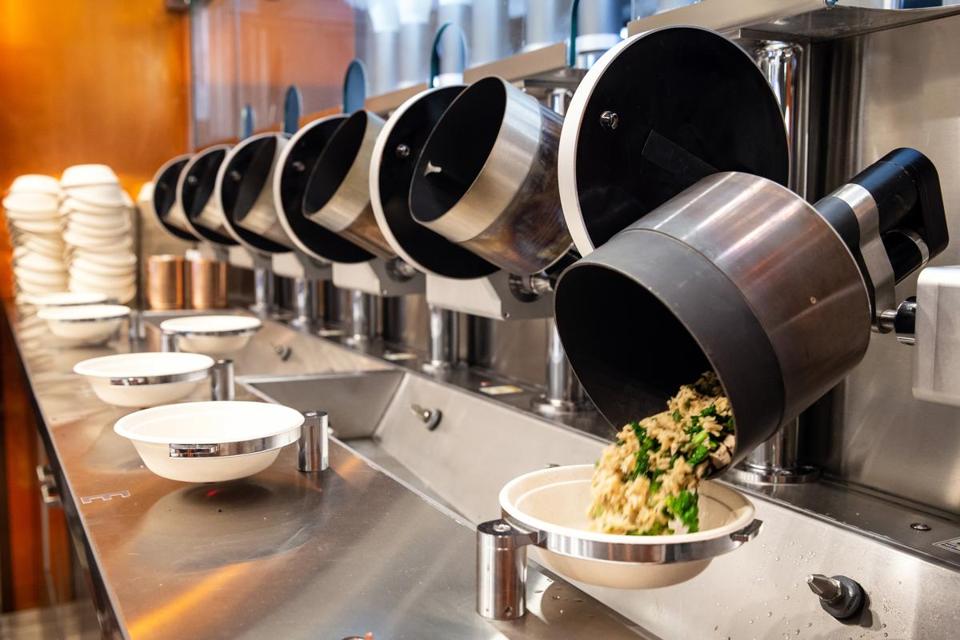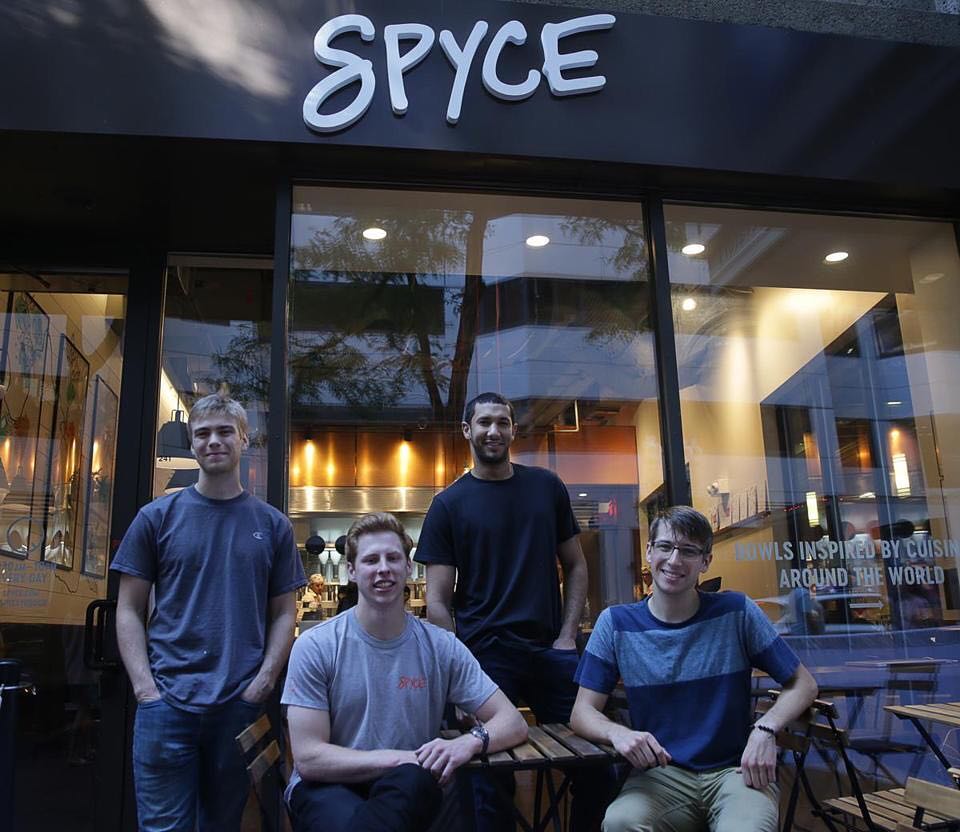Spyce Food, a Boston-based restaurant, serves healthy bowls and salads starting $7.50 apiece—a price cheaper than its competitors in the area. The lower price, without any compromise on quality, is possible because of Spyce’s robotic kitchen where a line of woks, not chefs, cook the meal. Founded by four engineers from MIT in 2015, the company raised a $21M Series A round, led by Collaborative Fund, Maveron, among others, in September 2018.
How Spyce Food Works
At Spyce, customers place an order through a touchscreen menu—choosing between options from rice to grain bowls, curries, salads, stir-frys, pasta or noodle bowls—and watch their meal get ready in under three minutes without human interference.
To get started, a robotic runner picks up ingredients you selected (you can customize your bowl) and stops at one of the seven woks at Spyce that will cook your meal. It drops off the ingredients inside the inductively heated wok, which then mixes and cooks your food. The wok whirls around with the ingredients and the sauces and once the cooking is completed, it tumbles the food on a dish. It then tilts down where it’s cleaned by a jet of hot water and steam before the automated cooking can begin all over again.
https://www.youtube.com/watch?v=9LqqcDL99UA
It’s not like no human is involved. The robotic kitchen can make 150 bowls an hour because the restaurant staff does the washing and cutting of ingredients to be loaded in the wok. The staff also adds the final touches to the meal—garnishes such as feta or pumpkin seeds or cilantro—and hands it over to the customer.
Starting A Robotic Kitchen
Spyce was started by Michael Farid, Kale Rogers, Luke Schlueter and Brady Knight, who describe themselves as “four really hungry MIT students who were tired of spending $10 on take-out lunches and dinners”. They wanted food that was nutritious but still in their budget. As robotics-obsessed engineers, the alternative came easy to them: “a robotic kitchen that cooked tasty and nutritious meals, served them, and cleaned up after”.
The process, however, was ridden with challenges. The earlier prototype, co-founder Knight says, “used a flame to cook the meal as opposed to induction”. But they soon realized its inefficiency and started using woks with induction lining.
After multiple iterations, the technology for the robotic woks was streamlined and the founders decided to bring in some culinary talent. CEO Farid cold emailed star chef Daniel Boulud who, to the founders’ great surprise was excited with the idea and offered to visit them in Boston. After that, Boulud not only invested in the company but also became the culinary director.
Boulud then roped in Chef Sam Benson as Spyce’s Executive Chef who worked on the recipes of the dishes Spyce now serves. And thus, the founders say, “Three years, many burns, bruises, and brussel sprouts later”, Spyce opened in Boston.
The Rise Of The Robotic Kitchen

Spyce’s robotic woks (PC: Boston Globe)
For a long time, robotic kitchens or cooking robots have been a marketing ploy or a gimmick. “Flippy”, a robotic arm that flipped burgers in Los Angeles is the biggest example. But Flippy was in no way a “cooking robot”. While the Spyce woks are performing one repeated task as well, the variety of dishes cooked make it reliable, useful and what everyone in the food industry wants—fast. But Spyce is not alone. Other robots that can cook entire meals are working, or are in the process of working, around the world. One prominent example is California-based Creator, a bot that automates the whole process of preparing a burger from cutting tomatoes to slicing, buttering, and assembling for $6.
Another Silicon-based enterprise is called Bear Robotics which developed not a robotic chef but a server named Penny. However, Penny, doesn’t eliminate the need for waiters and waitresses as it brings the food while the server places it on the table. At the moment, market reports say that the food robotics market will be worth $2.5B by 2022.
Each of these innovations present an understandable threat to those working in the restaurant industry. A study by the Center for an Urban Future, in fact, found that the automation potential for waiters and waitresses is 77%. Similarly, A 2017 study by the McKinsey Global Institute found that in accommodation and food services, half of the labor time is spent either in performing predictable tasks or operating machinery, the type of work that robots can do.
Therefore, on the bright side, automation could allow us to move away from monotonous, repetitive tasks to more fulfilling work that is, perhaps, focused on hospitality and creativity. However, some cooks and chefs have expressed disappointment over robots entering kitchen, arguing that cooking is an art and that even the chopping, dicing and running in and out of the kitchen is an enjoyable and important part of the job. At the moment, automation is limited and has a fixed use case—largely fast food. Therefore, the real takeover where the robot can cook anything in the culinary world is elusive.
Assembly-line automation, however, can help save costs.
The cost-saving nature of automation is driving businesses further. It enables Spyce, for example, to fit into a smaller space, save on rent and expand beyond this restaurant in Boston. More than pay, it’s also the increased reliability as customers know that neither the taste nor the time taken to receive their meal (3 minutes) will change. That’s a very important factor in the fast-food industry where there’s ample choice and only three meals in a day.

The Spyce Co-Founders (L-R Luke Schlueter, Kale Rogers, Michael Farid and Brady Knight)
The founders at Spyce have maintained that their restaurant business is only half about the food, the other half is about hospitality—something which needs humans. “The staff is there to greet customers and help them through the ordering, to put the finishing touches on the food, and hand it to the guest with a smile,” CEO Farid says.
Spyce’s initial goal was to deliver healthy food at a low cost, and it’s a goal they don’t want to waiver from. However, as hospitality and increasing loyalty is important, robots have become tools rather than the central theme. “Our hope”, Knight has said, “is that we sort of catch people with the robot that’s kind of a hook but they keep coming back because they enjoy the food.”
Subscribe to our newsletter



